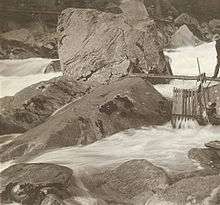Wenatchi
| Regions with significant populations | |
|---|---|
|
| |
| Languages | |
| English, Salishan, Interior Salish | |
| Related ethnic groups | |
| Colville, Sanpoil, Nespelem, Palus, Sinixt, Entiat, Methow, Southern Okanagan, Sinkiuse-Columbia, and the Nez Perce of Chief Joseph's band |
The Wenatchi people are a group of Native Americans who originally lived in the region near the confluence of the Columbia and Wenatchee Rivers in Eastern Washington State. They spoke Interior Salish (a variant of Salish) and ate salmon, starchy roots like camas and biscuitroot, berries, deer, sheep and whatever else they could hunt or catch. The river that they lived on, the Wenatchee River, had one of the greatest runs of salmon in the world prior to numerous hydroelectric dams being put in on the downstream Columbia, pollution and other issues, and was their main food source.
History

The Wenatchi tribe was far more isolated prior to the arrival of the horse, but afterward they adopted many of the traditions and style of dress of the Plains Indians and were closely allied with the Spokane tribes by the time white settlers arrived. It is also estimated that 90% of the indigenous population died prior to white contact, infectious diseases spreading with the horse far in advance.
The Wenatchis (or "P'squosa") were not given reservation land by the federal government- though they had actually signed a treaty, it was never recognized, and fell by the wayside as new settlers moved into their territory. The Wenatchi Indians unlike many other tribes did not engage in war with the new arrivals and were even friends with the first white settlers and their families. Janie Hollingsworth, an early settler born in 1911, remembers fondly growing up with the daughter of the Wenatchi Chief in the Nahahum Canyon area, riding horses together happily until the government decided to round up all the Indians and put them in existing reservations. Subsequently, most modern day Wenatchis are found living on the Colville Indian Reservation, with a small number living on the Yakama Reservation.
Further reading
- Chalfant, Stuart A. Ethnohistorical Reports on Aboriginal Land Use and Occupancy: Spokan Indians, Palus Indians, Columbia Salish, Wenatchi Salish. Interior Salish and eastern Washington Indians, 4. New York: Garland Pub. Inc, 1974. ISBN 0-8240-0782-4
- Gardner, Grace Christiansen. Life Among North Central Washington First Families - the Red Men. [Wenatchee: The Daily World, 1935.
- Marshall, Maureen E. Wenatchee's Dark Past. Wenatchee, Wash: The Wenatchee World, 2008.
- Scheuerman, Richard D. The Wenatchi Indians: Guardians of the Valley. Fairfield, Wash: Ye Galleon Press, 1982. ISBN 0-87770-287-X
- Scheuerman, Richard D., John Clement, and Clifford E. Trafzer. The Wenatchee Valley and Its First Peoples: Thrilling Grandeur, Unfulfilled Promise. Wenatchee, Wash: Wenatchee Valley Museum & Cultural Center, 2005. ISBN 0-9763591-0-3
- Smythe, Charles W., and Priya Helweg. Summary of Ethnological Objects in the National Museum of Natural History Associated with the Wenatchi Culture. Washington, D.C.: Repatriation Office, National Museum of Natural History, Smithsonian Institution, 1996.
External links
False Promises: The Story of the Wenatchi Indians